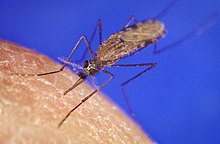Anopheles gambiae
| Anopheles gambiae | |
|---|---|
 |
|
| Scientific classification | |
| Kingdom: | Animalia |
| Phylum: | Arthropoda |
| Class: | Insecta |
| Order: | Diptera |
| Family: | Culicidae |
| Subfamily: | Anophelinae |
| Genus: | Anopheles |
| Species complex: | A. gambiae sensu lato |
| Species: | A. arabiensis, A. bwambae, A. melas, A. merus, A. quadriannulatus, Anopheles gambiae sensu stricto |
| Binomial name | |
|
Anopheles gambiae Giles 1902 |
|
The Anopheles gambiae complex consists of at least seven morphologically indistinguishable species of mosquitoes in the genus Anopheles. The complex was recognised in the 1960s and includes the most important vectors of malaria in sub-Saharan Africa, particularly of the most dangerous malaria parasite, Plasmodium falciparum. It is one of the most efficient malaria vectors known.
The Anopheles gambiae complex or Anopheles gambiae sensu lato was recognized as a species complex only in the 1960s. The A. gambiae complex consists of:
The individual species of the complex are morphologically difficult to distinguish from each other, although it is possible for larvae and adult females. The species exhibit different behavioural traits. For example, Anopheles quadriannulatus is both a saltwater and mineralwater species. A. melas and A. merus are saltwater species, while the remainder are freshwater species.Anopheles quadriannulatus generally takes its blood meal from animals (zoophilic), whereas Anopheles gambiae sensu stricto generally feeds on humans, i.e. is considered anthropophilic. Identification to the individual species level using the molecular methods of Scott et al. (1993) can have important implications in subsequent control measures.
An. gambiae s.s. has been discovered to be currently in a state of diverging into two different species — the Mopti (M) and Savannah (S) strains — though as of 2007, the two strains are still considered to be a single species. The An. gambiae s.s. genome has been sequenced three times, once for the M strain, once for the S strain, and once for a hybrid strain. Currently, ~90 miRNA have been predicted in the literature (38 miRNA officially listed in miRBase) for An. gambiae s.s. based upon conserved sequences to miRNA found in Drosophila.
...
Wikipedia
